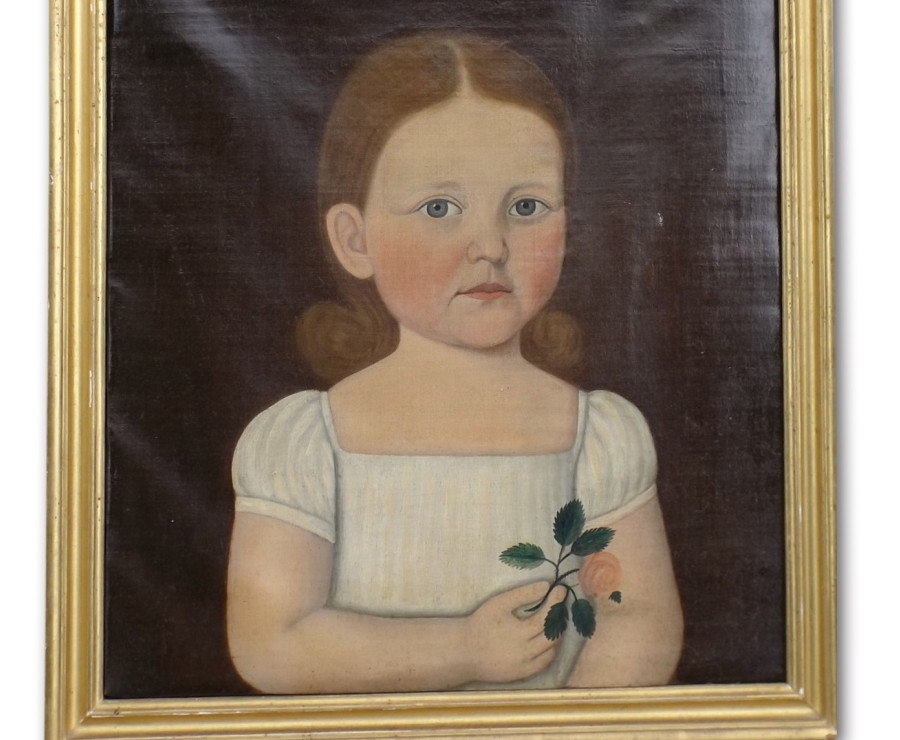The brown hair curls softly behind her ears, framing her cheeks with a cherubic, rosy glow. The child wears a white dress and holds a single flower between her fingers. But it’s Marcia Ingraham’s piercing eyes that grab you.
She gazes directly at the viewer with an eerie stillness.
The deaf itinerant painter John Brewster Jr. made the portrait in 1823. It sold at a Maine auction last month for more than $400,000, far exceeding the initial estimate of Massachusetts-based Caddigan Auctioneers.
“It’s a very modest painting, but we’re very pleased with the results,” auctioneer Joan Caddigan said.
Modest, perhaps, but Brewster’s reputation as a folk artist is unmatched. Born in Connecticut in 1766, he settled in Buxton and made his living traveling by coach across New England making portraits for wealthy families. He died in 1854.
This painting has been in the Cummings-Ingraham family since it was completed in 1823. Caddigan handled an auction of the family estate in late August in South Paris.
“It was an unbelievable sale, really,” Caddigan said. “The portrait we knew would do amazing things, but not quite as amazing as it did.”
Caddigan described the Cummings-Ingraham family as early settlers of Paris Hill Village in South Paris. It’s a small village in western Maine, settled in the late 1700s and known for its old homes and traditional New England setting. Many of its early inhabitants were summer residents.
The family’s home was full of fine china and furniture from the 18th and 19th centuries, including a chest of drawers that fetched $27,000 and a mahogany clock that sold for nearly $32,000. Before the sale, Caddigan estimated the value of Brewster’s painting at $100,000. The winning bid of $350,000 came by phone from a buyer who wishes to remain anonymous. With fees, the final cost was $413,000, she said.
The price surprised Thomas Denenberg, director of the Shelburne Museum in Vermont. He was curator at the Portland Museum of Art in Maine when it hosted an exhibition of Brewster’s work in 2007.
He thinks the high price can be attributed to Brewster’s growing reputation and the private nature of the portrait. The work, which is 15 inches wide and 18 inches tall, had been in the family since Brewster finished it.
“It’s new to the market, and anything that hasn’t been seen before is of great interest to the collector,” Denenberg said. “It’s the barn find.”
Brewster’s personal story adds to the conversation. Born deaf at the dawn of American independence, he also was unable to talk. Scholars believe overcoming these disabilities sharpened his visual skills. Painting was his best means of communication.
But it’s a wonder how he made his living as an artist, said Jessica Skwire Routhier, an independent museum professional who lives in South Portland. She is former director of the Saco Museum, which owns the largest collection of Brewster works, including three full-length portraits. The Saco Museum acquired its collection through donations by families over time.
“He could not hear, he could not read and he could not write,” she said. “It’s almost inconceivable how somebody could travel around New England and make business arrangements without being able to speak or read or write.”
Brewster moved to Buxton in 1795 to live with a younger brother, a doctor named Royal Brewster.
He traveled the countryside with his paints looking for business. He went from town to town, advertising his services in advance in local newspapers and often renting rooms for days or weeks at a time. When working on a full-scale portrait, he stayed in a family’s home. He likely communicated with his subjects with hand gestures, Routhier said – and also with his eyes.
That may explain why the eyes of his subjects are so penetrating.
“His eyes are very piercing, and the gaze is very direct,” Routhier said. “Eye contact was such an important means of communication between him and the people he was painting.”
Copy the Story LinkSend questions/comments to the editors.




Success. Please wait for the page to reload. If the page does not reload within 5 seconds, please refresh the page.
Enter your email and password to access comments.
Hi, to comment on stories you must . This profile is in addition to your subscription and website login.
Already have a commenting profile? .
Invalid username/password.
Please check your email to confirm and complete your registration.
Only subscribers are eligible to post comments. Please subscribe or login first for digital access. Here’s why.
Use the form below to reset your password. When you've submitted your account email, we will send an email with a reset code.